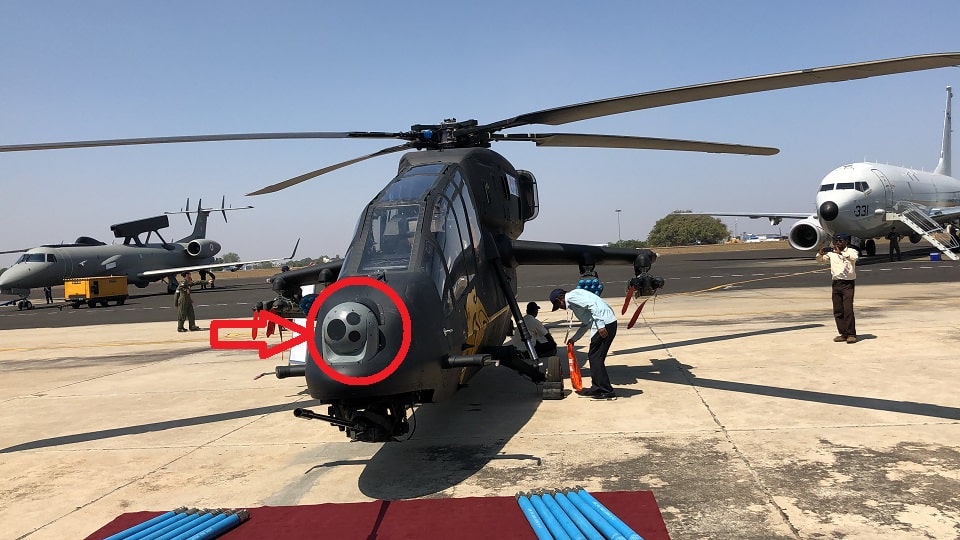Aerospace
How do the LCH and Dhruv Helicopter Surveillance Cameras function?
Have you ever wondered what type of camera is installed in the LCH helicopter and how it works?

This is the LCH and Dhruv Helicopter Surveillance Camera, which assists pilots in monitoring ground activity and providing other flying aid to aircraft.
The sensor enables the camera to give crisp imagery from severe darkness through the twilight transition phase. It is designed for a variety of nocturnal and extreme low-light imaging scenarios.
10 facts about the Light Combat Helicopter (LCH) made by Indian HAL. (Opens in a new browser tab)
It has a CCD camera, a forward-looking infrared imaging sensor, a laser rangefinder, and a laser designator to make target acquisition easier in all weather circumstances, including at night.
The camera was created exclusively for the Arrowhead Modernized Target Acquisition Designation Sight/Pilot on a Light Combat Helicopter.
IAF to induct first batch of domestically built LCH at Jodhpur (Opens in a new browser tab)
In the cockpits of most fighter jets and helicopters, there are many avionics gadgets that help the pilot make better decisions. Since this camera helps to resolute the display capability, it is tough to locate the landscape and the darker photos to achieve sharp focus in a warzone.
The LCA is a helicopter produced by Hindustan Aeronautics Limited, which also built the Dhruv Helicopter for the Indian Air Force. The majority of the technology is created by Bharath Electronic Limited in collaboration with a private company.
IAF to induct Made-in-India light combat helicopter at Jodhpur(Opens in a new browser tab)
The LCA is a high-altitude ground fighting helicopter that requires a sophisticated avionics system for surveillance. This camera will provide further benefits to the company’s operations. Please share your thoughts on the camera in the comments area.

Aerospace
When Ratan Tata was denied entry to the airfield at the Aero India show, he waited

During our visit to Aero India 2019, we had the unexpected opportunity to see Ratan Tata at the event, which was a thrilling moment for us. However, there was a surprising hiccup when the security staff didn’t allow him to enter due to a lack of a security pass.
Despite this, he remained calm and patiently waited for about 20 minutes until a member of the Tata team brought him the required pass, after which he calmly proceeded inside. It was a humbling sight, showcasing his composed demeanor even in such situations.
Ratan Tata ji is not only a renowned industrialist but also a trained pilot, holding a pilot’s license. In 2007, he became the first Indian civilian to fly the F-16 Falcon during the Aero India show in Bangalore—a proud moment for the nation.
His passion for aviation extended beyond flying, as he played a key role in shaping India’s aerospace industry. Under his leadership, Tata ventured into manufacturing and maintaining aerospace components while upholding its legacy of quality. Notably, Tata’s collaboration with Airbus to develop and manufacture the C295 aircraft is a testament to its growing influence in the sector.
-

 Aviation2 months ago
Aviation2 months agoMicrosoft Flight Simulator Raises $3 Million to Bring Back the An-225 Mriya
-

 Airlines2 months ago
Airlines2 months agoQatar Citizens Can Travel to the United States Without a Visa
-

 Aviation2 months ago
Aviation2 months agoQatar Airways bans these new Electronic Devices on plane
-

 Airlines2 months ago
Airlines2 months agoJapan Airlines Rolls Out Free Domestic Flights to International Passengers
-

 Defence2 months ago
Defence2 months agoWhich Country Has the Largest Fleet of Fighter Aircraft?
-

 Travel2 months ago
Travel2 months agoQatar Airways Launches Four Additional Flights from Amsterdam
-

 Airport2 months ago
Airport2 months agoWestern Sydney Airport Welcomes Its First Plane After 6 Years of construction
-

 Airlines4 days ago
Airlines4 days agoDAMAC Air: Dubai’s New Luxury Airline Offers Free Flights for Registration








